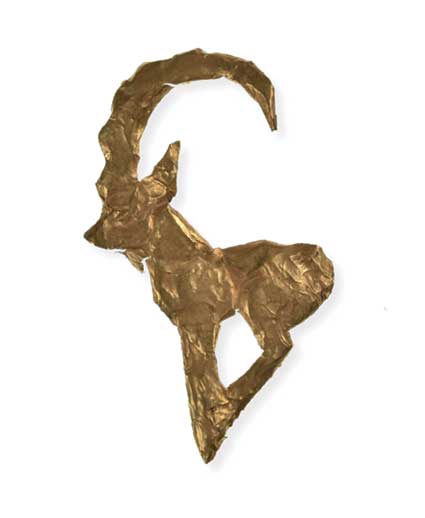Land of the Golden Man and the great kurgans, Kazakhstan is a land of legends situated on the edge of the steppes of Central Asia. This exhibition on treasures from the Great Steppe offers a history through five treasures that explore five major milestones of the civilisation, from the 3rd millennium BC to the 18th century. One of the five countries of Central Asia, at the crossroads between Asia and Europe, it is known for its unique historical and cultural development. The land was first populated by nomadic peoples, who dominated the steppes, with major urban centres of settled populations emerging in later centuries. The wealth of natural resources contributed to the development of international trade, bringing prosperity that further strengthened the cultural identity of the region. The Huns, Scythians, and Turkic tribes all played a key role in shaping Kazakhstan’s culture, identity, and political alliances. After the decline of the Golden Horde, the Kazakh khanate emerged as the successor to Genghis Khan’s empire, laying the foundations for the traditional civilisation of the Kazakhs.
The first treasure in the exhibition is the Thinker of Tobyl, from the Botai, an archaeological culture (circa 3700-3100 BC) of prehistoric northern Central Asia. The Botai culture emerged with the transition from a nomadic hunter-gatherer lifestyle with a variety of game to a sedentary lifestyle with a diet that relied heavily on horse meat. The transition of lifestyle from ancient nomadic tribes to an economy based on horse breeding is a major development of this period on the Steppe.
The second of the Kazakhstan treasures is the Golden Man, which heralds the emergence of the first Scythian states. During the 1st millennium BC, large federations of tribes and proto-states sharing a common culture began to develop on the Eurasian steppes. These nomadic tribes, were called the Scythians, Saka, or Sarmatians by the Greeks and Persians. The most important centres of Saka state formation were in southeast Kazakhstan (in the Jetissu), in the northern lakes and steppes region (Saryarka), near the Aral Sea, and in the Altai Mountains. The ethnic proximity, the parallel development of their societies and the way of life of these diverse peoples generated a common culture, technologies and production of objects.
In goldsmithing, for example, a common ‘animal style’ was particularly popular. The discovery in 1969 of the Golden Man in Issyk, in the Almaty region, caused a sensation in the scientific community. The refinement of the gold ornaments of this high-status man attests to a high degree of mastery of goldsmithing techniques. He also reflects the richness of the mythology and spirituality of the steppe civilisations. These nomads obviously venerated their leader, elevating him to the status of a solar deity. On one of the silver cups found near the grave shows traces of the oldest writing yet discovered in Central Asia.
The third treasure is represented by Balbal to represent the development of medieval Kazakhstan at the time of Turkish hegemony. The balbal are megalithic funerary steles that are emblematic symbols of the nomadic Turkic populations. These anthropomorphic sculptures allow them to be identified with female and male figures, and can be found throughout the steppe world.
The candlesticks of the Mausoleum of Khoja Ahmed Yasawi are the fourth of the Kazakhstan treasures and represent the development of Islam. Ahmet Yasawi (1093-1166) was a 12th-century Sufi poet and mystic who played a decisive role in the development of Islam and Sufism in the Turkic territories of Central Asia. He came from Yasi, now Turkistan, a prosperous oasis on the trade routes that connected China to the Middle East. His mausoleum was built during the time of Timur sometime between 1389 and 1405. The Timurid empire (1370-1507) ruled over a territory that included Iran and Central Asia.
The mausoleum’s architects were of Persian origin and experimented with new architectural solutions, including the use of blue and turquoise bricks decorated with geometric decorations, which were later adopted for the construction of the capital in Samarkand. Today, it is one of the largest and best-preserved buildings from the Timurid period. For the interior decoration of the mausoleum, six candlesticks had been commissioned by Emir Timur. Made of metal, most likely inlaid with gold and silver, they are typical of Islamic decorative art of the Timurid period. In their time they were considered objects of great luxury and bore either the name of the commissioner or that of the craftsman and the precise date of manufacture.
Finally, the fifth treasure of the Kazakhstan treasures is the chapan (coat) of Kazybek biy Keldibekuly, the focus of the exploration of the rise of the Kazakh khanate and the emergence of modern Kazakhstan. Between the 15th and 17th centuries, most of the territory of modern Kazakhstan was administered by the Kazakh Khanate (1465-1718). It was one of the successor states to the Golden Horde, founded around 1465-66 in southern Kazakhstan by two descendants of Genghis Khan, Kerei Khan and Janibek Khan, as the Mongol and Golden Horde hegemony in Eurasia came to an end.
It was during this period that the Chinese Ming dynasty (1368-1644) came to power in China after the collapse of the Yuan dynasty (1234-1368), founded by the Mongols, and that Ivan III of Russia, known as the Great (r 1462-1505), declared Russia’s independence from the Golden Horde in 1480. The emergence of the Kazakh Khanate was a turning point in the history of Kazakhstan: it saw the establishment of a nation with a united cultural and ethnic community for the Kazakhs. The khanate modelled its governance on the political alliances and states that had existed before it, allowing judicial authority to be exercised by judges elected by the people. The court of these judges, adapted to deal with nomadic or semi-nomadic peoples functioned until the beginning of the 19th century. One of these judges was a prominent diplomat and statesman, Kazybek biy Keldibekuly (1667-1764).
Kazakhstan: Treasures of the Great Steppe, until 24 March 2025, Musée Guimet, Paris, guimet.fr




